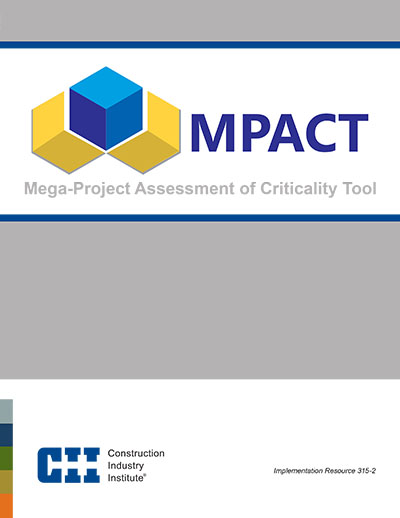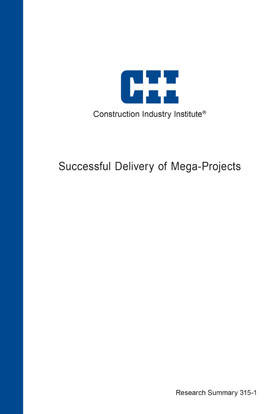
Mega-Project Assessment of Criticality Tool
As the number and size of mega-projects continue to increase across all sectors of the capital projects industry, one fact stands out: they tend to underperform more often than not—whether because they fail to keep within their approved budgets, follow their approved schedules, or meet their premised business objectives. Although it would seem that traditional project management techniques would be sufficient to keep mega-projects on track, this is not the case; these projects challenge even the most experienced owner and contractor project teams. Even when organizations use proven best practices and tools, most of their mega-projects still do not achieve the objectives established at approval. Given the enormous amount of capital dollars at stake and the prevailing trend towards poor performance, the Construction Industry Institute (CII) initiated Research Team (RT) 315, Successful Delivery of Mega-Projects, to determine why these failures happen and what can be done to prevent them or mitigate their consequences. Specifically, RT 315 was tasked with answering the following question: What sorts of changes in project development and execution are needed to improve the probability of successful mega-project outcomes?
To accomplish this objective, the research team identified 34 factors that have high frequency and negative performance impacts on mega-projects, categorizing them into the following five categories: 1) Location and Technology; 2) Team, Organization, and Communications; 3) Planning Execution Processes; 4) Governance and Stakeholders; and 5) Delivery Strategy. Through its extensive data collection efforts, RT 315 gathered in-depth information about these impact factors to help project teams better manage and mitigate their effects. After synthesizing this information into useful recommendations, the team incorporated them into an easy-to-use Excel-based tool called the Mega-Project Assessment of Criticality Tool (MPACT). This guide introduces and explains how and when to use this tool.
The MPACT tool allows project teams to assess which of the 34 impact factors are relevant to their projects, conduct project-specific criticality assessments, incorporate project team recommendations, access real project case examples and recommendations, and generate customized reports. The MPACT tool is designed to complement but not replace any other planning and execution processes used by an organization (e.g., risk assessments). In developing this tool, the research team went beyond the previous generic approaches to mega-project management, instead giving project teams the means to raise awareness of and stimulate thinking on these mega-project impact factors, and, thus, improve their odds of mega-project success.
Benefits of the MPACT Tool
The MPACT tool can be used on any scale and type of mega-project, and provides the following:
- a methodology for assessing the 34 key impact factors identified in the research
- in-depth information on these impact factors, including detailed descriptions, research findings, and real case examples
- recommendations for mitigating the impacts of these factors during mega-project front end planning and execution.
IR315-2, MPACT Mega-Project Assessment of Criticality Tool
The MPACT tool is designed to help project teams assess the factors that are most significant to their projects and to provide a library of mega-project experience in managing or mitigating these factors. The tool can be used on any scale and type of mega-project, and provides the following:
- A methodology for assessing the 34 key impact factors identified in the research
- In-depth information on these impact factors, including detailed descriptions, research findings, and real case examples
- Recommendations for mitigating the impacts of these factors during mega-project front end planning and execution



